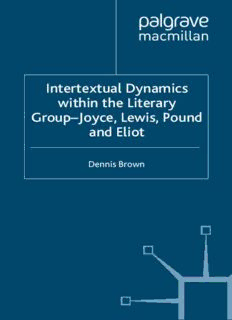
Intertextual Dynamics within the Literary Group - Joyce, Lewis, Pound and Eliot: The Men of 1914 PDF
Preview Intertextual Dynamics within the Literary Group - Joyce, Lewis, Pound and Eliot: The Men of 1914
Intertextual Dynamics within the Literary Group–Joyce, Lewis, Pound and Eliot Dennis Brown INTERTEXTUAL DYNAMICS WITHIN THE LITERARY GROUP - JOYCE, LEWIS, POUND AND ELIOT Also by Dennis Brown MS MOFFATT (under the pen-name Ned Brown) *THE MODERNIST SELF IN TWENTIETH-CENTURY ENGLISH LITERATURE: A Study in Self-Fragmentation *Also published by Macmillan Intertextual Dynamics within the Literary Group - Joyce, Lewis, Pound and Eliot The Men of 1914 Dennis Brown Principal Lecturer in English Hatfield Polytechnic M MACMILLAN © Dennis Brown 1990 All rights reserved. No reproduction, copy or transmission of this publication may be made without written permission. No paragraph of this publication may be reproduced, copied or transmitted save with written permission or in accordance with the provisions of the Copyright, Designs and Patents Act 1988, or under the terms of any licence permitting limited copying issued by the Copyright Licensing Agency, 33-4 Alfred Place, London WC1E 7DP. Any person who does any unauthorised act in relation to this publication may be liable to criminal prosecution and civil claims for damages. First published 1990 Published by THE MACMILLAN PRESS LTD Houndmills, Basingstoke, Hampshire RG21 2XS and London Companies and representatives throughout the world Typeset by Wessex Typesetters (Division of The Eastern Press Ltd) Frome, Somerset WBC Print Ltd., Bridgend, Mid Glam. Bound by WBC Bookbinders Ltd., Bridgend, Mid Glam. British Library Cataloguing in Publication Data Brown, Dennis, 1940- Intertextual dynamics within the literary group— Joyce, Lewis, Pound and Eliot: the men of 1914. 1. English literature, 1900-1945. Modernism- Critical studies I. Title. 820.9'00912 ISBN 0-333-51646-X For Sam, Darren and Andrew This page intentionally left blank Contents Preface ix 1 Introduction 1 2 To Announce a New Age 8 3 The First Heave 54 4 The Great Decade 89 5 Lost in the Labyrinth 125 6 These the Companions 158 Notes 191 Index 223 Vll II n'y a pas dehors de texte —Jacques Derrida There are no texts. There are only ourselves —Harold Bloom A common theme . . . expressing itself in different ways through various mouths' —S. H. Foulkes and E. J. Anthony Preface In the Preface to my recent academic book The Modernist Self, I proposed, for a follow-up, to make my next venture a study of the interpsychic mechanisms whereby a Modernist discourse was constructed. This book is the result. It focuses on four key writers of the Modernist movement; however, it is more about intertextual influence than psychological mechanisms as such. I am grateful to my onetime postgraduate student Marilyn Miller-Pietroni (psychotherapist and editor of the Journal of Social Work Practice) for pointing me in the direction of group-psychoanalytic literature: my rather basic reading of this informs some of my interpretations of what the Men of 1914 were about. I am also grateful for the continuing interest of Hatfield Polytechnic lecturers and students in my work - and, in particular, for some brilliant suggestions by our part-time MA student Keith Miller in response to lectures based on my early work for the book. My colleague Jean Radford gave support and encouragement when I showed her early chapters and Eric Trudgill (of Hatfield) and Patrick Grant (of the University of Victoria) have again given advice and encouragement after reading my entire first draft. My one-time English teacher J. E. Lindsay and my ex-colleague Alexander Hutchisson both boosted my confidence at important moments during the writing, while my unknown Macmillan's reader offered some cogent advice about my original Introduction which I have followed in the main. I am extremely grateful again to Margaret Carpenter who typed ongoing sections of the book, as they were written, with great speed and accuracy despite her heavy work-commitments. I wish, too, to thank Dorothy Koenigsberger who, as Humanities Research Coordinator, provided an ethos of scholarly effort and interdiscipli nary discussion out of which this book was written and which contributed to whatever it has achieved, in finally incalculable ways. Alan Weir, of the Polytechnic, was also a valued inspiration through his interest in a year that was difficult for both of us. Most of all, I must thank my wife Sam for genuine and selfless enthusiasm for a project that could have divided rather than united us, but for IX
Description: